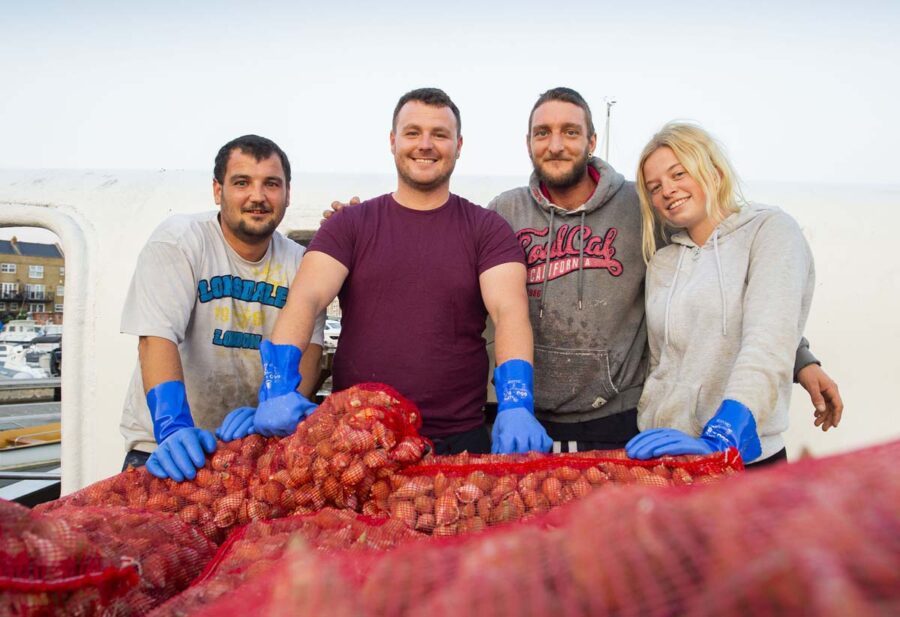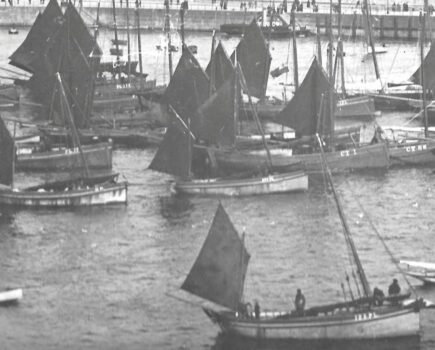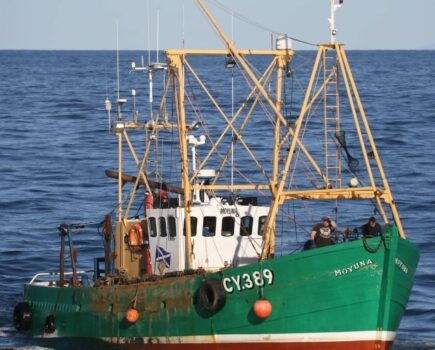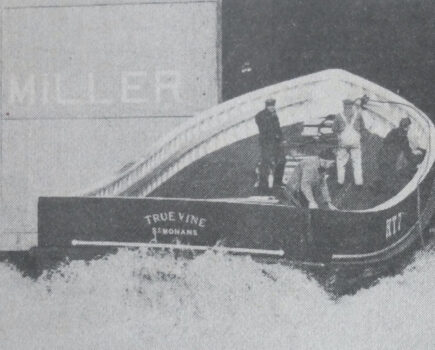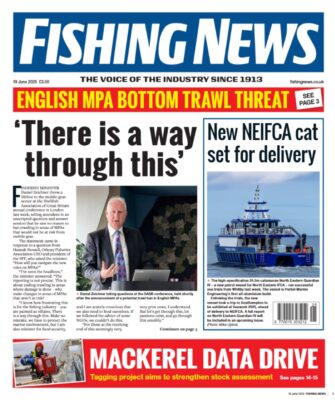With young local recruits and a new quay underway, the Eastbourne fishing fleet is looking to the future, reports John Periam. Photographs by Geoffrey Lee
Joe Watt had no family connections to the fishing community in Eastbourne; fishing was just something he wanted to do. Aged only 14, he bought himself a 16ft beach boat with an outboard, which he used for trammel-netting off the beach with a fleet of nets that he made himself.
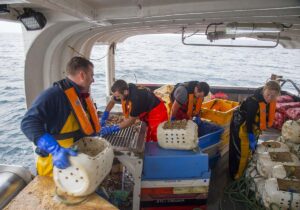
01. The whelking production line in full swing on Britannia.
On leaving school, he started an apprenticeship as an architect – but the sea still beckoned. He took his little boat out every free moment that he had, and soon decided that he wanted to fish full-time. At the age of 21, he bought an Islands Plastic IP27, and other boats followed. “I loved every minute of it, and every time I went to sea, it was a learning curve. I invested well with my boat purchases, and made sure they were equipped with the best gear possible,” he said.
Today, his business Britannia Fishing Ltd owns five catamarans: Britannia NN 791, skippered by his son Danny Watt, Clar Innis NN 732, skippered by Scott Possnicker, Havana NN 749, skippered by Ian Smith, Columbus NN 794 and Flo Fan CS 8.
In mid-September, Fishing News was invited to join Danny Watt and his crew for a day’s whelking. Photographer Geoffrey Lee reported to Eastbourne’s Sovereign Harbour at 2.45am, with the day’s forecast showing a 7-9mph NNW wind backing NNE.
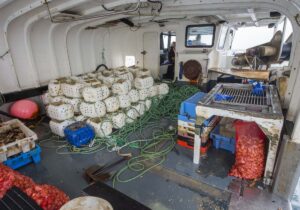
02. The deck layout, with a string of pots ready to be reshot.
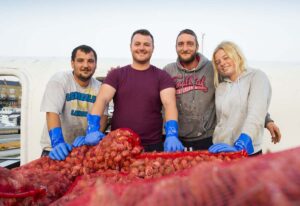
03. Britannia’s crew, left to right: Mark Anderson, skipper Danny Watt, Ben Williams and Hollie Irving.
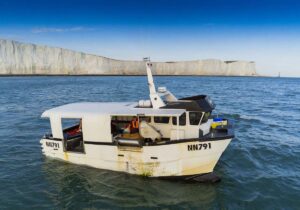
04. Britannia passes Beachy Head, heading in to Eastbourne.
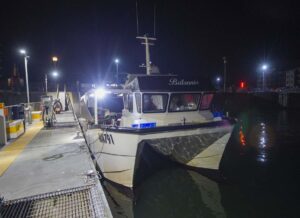
05. Britannia takes on diesel before leaving Eastbourne marina at 3.30am.
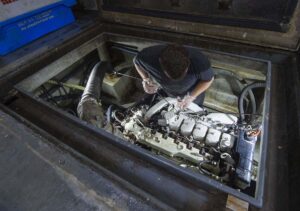
06. Skipper Danny Watt checks the oil level on one of the FTP Iveco engines.
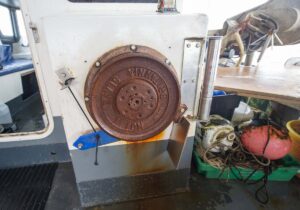
07. The 1.5t Britannia slave pot hauler.
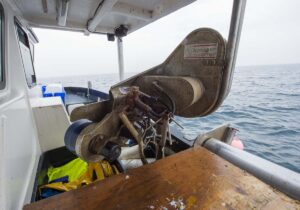
08. Britannia is also equipped with a Spencer Carter net hauler.
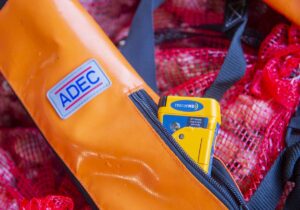
09. The crew’s ADEC PFDs have a zipped pocket housing their Ocean Signal PLBs.
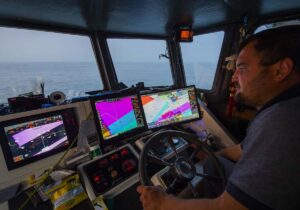
10. Mark Anderson navigates Britannia to the location of the first string of pots.
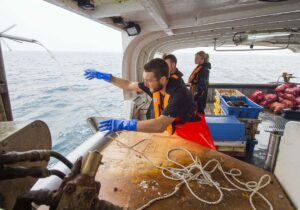
11. Ben Williams throws the grappling hook at the buoy and hauls it aboard.
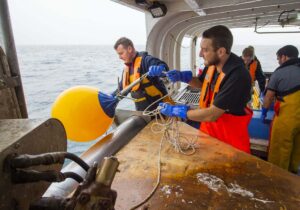
12. Danny Watt hauls in the second buoy…
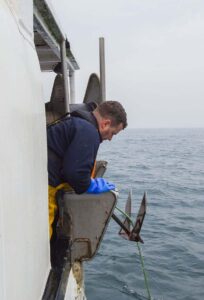
13. …and the14kg sand anchor.
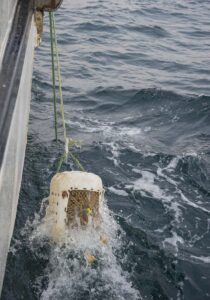
14. Hauling the first whelk pot…
Danny Watt’s second-in-command for the day was Mark Anderson from Selsey, who joined him earlier this year as relief skipper. Mark started fishing in 2009, working with Selsey fishermen Geoff Birkett on Zeus LI 135 and John Reeves on Nicholas C LI 90.
Also onboard was Ben Williams from Eastbourne, who has been fishing since he was 16 and has crewed on many local boats. He joined Danny a few months ago, after a spell ashore as a fishmonger at Brighton and Newhaven Fish Sales at Portslade.
Last but not least was the crew’s newest member, Hollie Irving – the first fisherwoman in the local area. Aged 21, she started her fishing career in April this year on Filo NN 784 with skipper Steve Bradshaw, and this was her first day working for Danny.
Danny is enthusiastic about training up his young crew, having himself, like his father, wanted to go to sea from an early age. “I like to give people an opportunity in life – the industry needs young blood, and if I can help, I will.”
Britannia NN 791 was built in 2014 by Southampton-based Catapult Catamarans Marine Projects. It has a glass-fibre hull and main dimensions of LOA 9m, beam 4.9m and GT 9.38t. Powered by two FPT Iveco NEF N67 175hp (130kW) marine diesel engines, Britannia is fitted with Twin Disc gearboxes of 2:1 reduction, 2in shafts and 24in three-bladed bronze propellers, giving a cruising speed of 7-8 knots.
The wheelhouse is equipped with Simrad radar/AIS NSS Evo 3, Neovo and Asus screens with TZ Professional software, MaxSea plotter, Icom IC-M506 DSC VHF, Simrad A2004 autopilot and three sets of electronic Kobelt throttles – one in and one outside the wheelhouse, and one on the starboard gunwale.
Below the main bench on the port side of the wheelhouse, two berths are located so that crew can rest during the long transits to and from the fishing grounds.
The deck is laid out for potting and netting, with sufficient space to safely operate a four-person potting production line. On the starboard side is a Spencer Carter NH03 net hauler, which runs off the clutch pump from the starboard engine. The 48in gunwale roller was supplied by Dave Sutton of Newhaven-based Sutton Workboats, and the 1.5t slave pot hauler came from Britannia Engineering SW Ltd, in partnership with Hercules Hydraulics.
Britannia targets whelks from the start of the season on 1 April until early autumn, when skipper Danny Watt switches to netting for Dover sole, turbot, plaice and skate along the south coast between Ramsgate and Shoreham. He is also thinking about targeting spider crabs, which are plentiful locally, if he can find a suitable outlet.
The crew wore ADEC PFDs, which have a zipped pocket housing an Ocean Signal personal locator beacon. Danny Watt made mention of the benefit of the Seafish grant of up to £200 towards the cost of purchasing PFDs and PLBs for fishing boat crew.
After fuelling the boat and loading the day’s bait, skipper Danny Watt steered Britannia towards the marina lock, which opens on the hour and the half-hour, to exit into the Channel.
Britannia left the marina at 3.40am and set course for a position 33 miles southeast at a steady eight knots. Danny then handed the wheelhouse controls to relief watch Mark, who guided the boat through the busy waters of the Channel in the misty conditions before dawn, ensuring sufficient distance to avoid the wake of a number of 400m-plus container ships that were encountered.
Britannia reached its first set of strings, south of the southern shipping lane near the UK-French maritime line, at 7.30am. Each string consists of 100 x 25-litre cement-weighted whelk pots from Sutton Workboats. The strings were aligned north-south, in 35m to 40m depth of water.
Once Britannia was in position, Danny threw the grappling hook at the buoy to bring it onboard. Having placed the rope around the slave hauler, he then hauled in another buoy, then the sand anchor and finally the first of the pots. This was a smooth operation in which his long experience showed.
Each string is made up of A0 or A1 buoys, then 35 fathoms of 8mm Shamrock twisted leaded rope, and then a cork float, 20 fathoms of 8mm rope attached to a 14kg sand anchor, and 10 fathoms of 18mm backline rope. Then come the pots, spaced seven fathoms apart, and finally the leg rope, which is one and a half fathoms of 18mm rope, attached via a spinner.
Using the throttles and hauler control, Danny hauled the pots, opening the bait strings before placing each pot on the riddling grate table. Mark then shook the pots to remove the whelks and old bait, placing the empty pot behind him each time. Emptying the pots over the riddling grate, which is set to the minimum size of 25mm, lets undersized whelks fall through into a box ready to be returned to the sea, while those meeting the regulation size are dropped into a sack at the end of the table. Once full, each 35kg sack is lifted to the aft deck and replaced with a fresh one.
Working next to Ben, Hollie rebaited each pot with fresh brown crab and spotted dogfish, drawing the pot strings tight to retain the bait. They use roughly two bags of crab and half a box of dogfish per 100 pots. Ben stacked the pots on the port side of the deck, making sure the strops and backropes were clear so they could be reshot in the right order.
Once all 100 pots on the first string had been hauled, shaken, rebaited and stacked, Danny used the GPS receivers and plotter to steer Britannia to where he planned to reshoot the string. Meanwhile, Hollie tied up the sacks and Ben washed down the deck.
When the catamaran was in position for reshooting, Ben threw in the blast buoy and sand anchor and then placed the pots on deck, ready to be reshot via the starboard opening doors. Safety was paramount here, watching the ropes carefully to ensure that none of the crew became entangled. “We keep an eye out for each other all the time,” said Danny.
The complete process takes about 40 minutes per string. After two strings have been hauled and reshot, Danny swaps his crew around to give them a spell on a different job. Whelking is a very physical job – hauling, shaking, riddling and shifting the weighted pots around a moving deck.
After seven strings had been hauled and reshot, 49 sacks of whelks were onboard and it was time to begin the three-and-a-half-hour steam back to Eastbourne.
In the summer, Britannia’s daily catch of whelks can be up to 80 sacks. The whelking season was now drawing to a close, with French scallopers shortly due to move into the area.
In the distance, the white cliffs of Beachy Head and the Seven Sisters were lit up by the setting sun. Britannia returned to the marina just in time for the 6.30pm opening of the lock. Back on the mooring, the sacks of whelks were unloaded onto a trailer, ready to be transported by lorry overnight to Macduff Shellfish for cleaning and distribution. Britannia was prepared for the following day’s fishing and, after their 14-hour day, the crew headed home to bed.
Watt family fishing
In the days when Joe Watt started to fish, all the Eastbourne fishermen worked from the beach by the lifeboat station. At that time, there were many part-time fishermen in addition to the full-time fleet. In 1992, Eastbourne’s Sovereign Harbour was built, and the owners encouraged the under-10m fleet to move into a separate area and work from there. About 20 of them did so.
In the summer months, whelking can take the Eastbourne fleet right across the Channel to work off the French coast. In the winter months, they tend to fish more along the south coast, at times going as far as Ramsgate to the east and Shoreham to the west.
The Eastbourne fishing community is quite a strong one, with a local fishermen’s association and stalwarts such as Pevensey-based Graham Doswell, who has worked hard for many years on behalf of them all. “You know what fishermen are like – we are very independent and keep ourselves to ourselves. Of course, if anyone is in trouble at sea or has family issues, we pull out all the stops to help,” said Joe.
“Having Sovereign Harbour as a base has been a real bonus for us – it gives us protection in inclement weather and the opportunity to unload our catches directly onto the mooring, so we can then arrange transport to our suppliers. It also gives us ease of access to our boats for maintenance, with vehicle parking alongside.
“I have several boats now, and currently we are fitting out a new Gemini 9.9m netting and potting boat from Anderson Marine up in Peterhead. We took delivery from them in May, and it should be ready to go to sea by the end of this year.”
Joe has a good relationship with his wholesalers, which has been crucial during this difficult year. “Prices fluctuated, as we export a lot of our catches to Belgium and France; as those markets closed, we had to sell more in the UK, often at a lower price. Our whelks and some shellfish are exported to China and South Korea. Brighton and Newhaven Fish Sales is very supportive of us and looks after our shellfish sales. PH Fish at Hastings looks after our wet fish sales.
“Currently fishing is a 24/7 job as a result of the virus, and we also have the ongoing Brexit situation. None of us know what will happen. We do not want to fall out with our European fishing counterparts – we currently have a good working relationship with those who work the Channel, and the last thing I want to see is this damaged as a result of these proposed changes. A lot of our fish goes to Europe, so we need to continue this.”
Each of Britannia Fishing’s boats normally has a crew of three or four, including the skipper. Joe said: “We can rely on our crews to do a good day’s work. In return, I try to look after them well. In the current times, it is not easy to find new crew members.”
He is very keen to encourage young people into the industry. “The cost of purchasing a new vessel prevents many youngsters from doing it today. Then there is the running of it, and that puts one under a lot of pressure at times. I started with nothing – I accept that times were different then – but am proud to see what I have achieved, and so if I can help others, I will.”
A real bonus for the Eastbourne fishermen is the long-awaited approval for a new fishermen’s quay in Sovereign Harbour (Fishing News, 3 September, ‘Work finally starts on Eastbourne’s new fishing quay’). Joe said: “It has taken a lot of hard work to get where we are, and it is nice now to see the work being started. Graham Doswell worked very hard in conjunction with Chris Williams from the New Economics Foundation. It will help us a lot, while giving visitors to the harbour the opportunity to buy fish direct and meet the fishermen.”
Danny Watt, who is now 29, started fishing as soon as he left school. “It was the next day,” he said with a broad smile. “My dad took me out at any opportunity. I have grown up with it in the family, and it was my decision to do it. My dad did not push me into it at all. He has always stressed the importance of safety at sea, and I attended several courses as a result, keeping ahead of the legal requirements. Now any new young crew member is put through the same regime.” Danny qualified as a skipper at the age of 19.
He is cautiously optimistic about the way ahead. “Currently it is all about adaption and adjusting to the times. It is better to go with the flow, in my view, than cause friction – there is room for us all, but each of us must evaluate our fishing areas and try and work together.”
Joe Watt added: “When the Brexit transition period ends, there could well be a few sticking points, but I feel confident that if we are guided right and make an effort to get on with our EU counterparts, it should not be a problem. People worry, of course, and currently it is all about the unknown. We need to look for the positives in everything.”
The word ‘paperwork’ again reared its head; Danny feels that there is far too much at times. The new Catch App, he says, does not always work, often at the time when they want to go home. However, he says of the MMO and Sussex IFCA: “I am aware that they are there to protect us, and appreciate that they have to monitor the current rules and regulations.”
Danny’s new female crew member, 21-year-old Hollie Irving, has been fishing for six months, having previously worked in a bar in Eastbourne. “I went for a day trip on my day off, and liked it – fresh air and a fresh challenge. It was of course a learning curve, but I have now adapted to going to sea in all weathers. I will be the first to admit that at times some of the heavy work is not that easy, but I am learning more each trip.
“I have got used to setting my alarm clock and keeping my working gear ready by the back door. I really respect the Eastbourne fishermen for the trust they have had in me, and I won’t let them down.” Her ambition is to be the first female skipper at Eastbourne.

